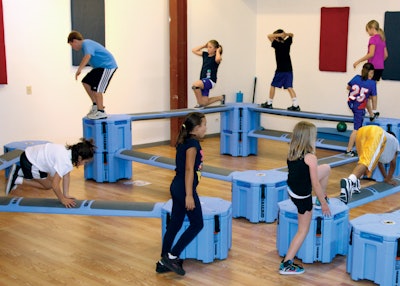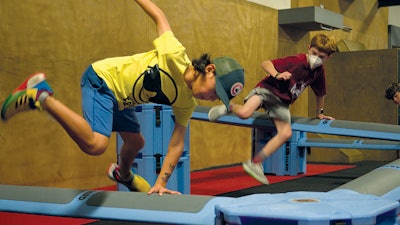
Children as a fitness group are different from their gym-going elders. They’re not there to burn calories or get in their steps, and they’re not going to be active for activity’s sake. For kids, the fitness has to be fun.
“Kids are concrete thinkers and adults are abstract thinkers,” says Railyard Fitness Inc. founder Lee Spieker. “Adults, we exercise for our health, which is an abstract. Kids exercise for two reasons: It’s got to be fun, or they’re making an adult happy. They don’t choose to do abstract things.”
In order to make fitness more conceptually concrete for kids — but flexible and safe for parents and instructors — Spieker created a portable, indoor obstacle course in 2007 that’s made out of plastic modular pieces that can be configured and reconfigured to create multiple climbing, crawling, balancing and jumping obstacles.
Youth fitness director Tasha Buchanen has been using a Railyard system at Clarksville (Tenn.) Athletic Club for years. She says it was an item she had to have when she took on the job in 2012 because of the fun — and program flexibility — it offers.
“It’s so versatile, there’s so many things you can do with it. It’s not just like you set one course and leave it. There are so many different options for this,” she says. “And so many different age groups. Before COVID, we had a 2- to 3-year-old program. I had those 2- to 3-year-olds on the unit and we had 15 kids in the class. It was amazing for them. They loved it.”
The Railyard system includes four parts: a 9-inch platform, an 18-inch platform, a 7-foot rail that’s reversible (flat on one side and round on the other), and the rubber latching platform tops that lock the whole thing together.

Hidden gem
In a fitness facility setting, the Railyard system offers three clear benefits: variety for programming, encouragement for returning members, and appeal as an athletics alternative. Spieker explains: “It’s not a sport. You can suck at sports, but you cannot suck at exercise. Even in schools today, and I do workshops for physical education all over the country, that’s one of the things they bring up: not all kids are interested in sports.”
Buchanen calls the system at her facility the athletic club’s “hidden gem,” because while it’s in the youth room for classes four days a week, she also gets to bring it out for special events, where it attracts a lot of attention.
“When we have birthday parties, and I’m doing an obstacle course for that, we use half of our basketball court and I set the entire unit up on there,” Buchanen says. “And I’ll get parents coming over and looking who aren’t part of the birthday party, and they’re like, ‘What’s this?’ I’ve had people come up, ask questions, and they’re like, ‘Wow, that’s really cool.’ ”
At many clubs, the 5-15 age group is not always offered functional exercise programs of interest to them. They’re a type of member that often ages out of childcare but can’t participate in adult group X or the weight room for several intervening years. Spieker says offering youth programming like obstacle courses — similar to ninja-type climbing and popular parkour training — can draw a loyal crowd to a facility.
At the Clarksville Athletic Club, Buchanen says the class offered there not only brings the kids back, but their parents, too.
“A lot of kids in our program kind of help their parents come to the facility because they want to come to class,” Buchanen says. “That’s a huge plus. We do get feedback from the parents that sometimes when they’re not feeling it, their kids are, and their kids kind of help them come because they say, ‘I want to go to Kids in Motion.’ ”
The system isn’t designed exclusively for children. Spieker says current adult users include the San Francisco 49ers, the Chicago Bears, the Penn State football team and Wisconsin’s volleyball team. He says it’s also in use at nine police athletic academies. “Police and firefighters, this is how they perform their jobs. They run at something, they duck, they climb, they crawl and train for an active profession.”

Mental health movement
Making the Railyard all the more relevant for today’s generation of kids are the mental health benefits that having fun and building functional movement skills bring. “If you’re a young child, you have confidence in the way you move, and self-esteem because you accomplish a certain thing,” Spieker says.
In Clarksville, Buchanen says she’s seen the system pay off similarly. “Not every child wants to run. Not every child wants to move,” she says. “A lot of the kids look forward to using the unit and they like the way they feel afterwards. And they see themselves getting stronger.”





































